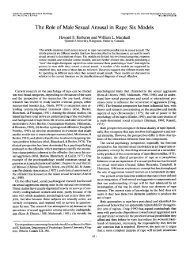Regulation of the dopamine transporter - Addiction Research ...
Regulation of the dopamine transporter - Addiction Research ...
Regulation of the dopamine transporter - Addiction Research ...
You also want an ePaper? Increase the reach of your titles
YUMPU automatically turns print PDFs into web optimized ePapers that Google loves.
DAT <strong>Regulation</strong> Schmitt & Reith<br />
that <strong>the</strong>y are bona fide neuromodulators. �-<br />
Phenethylamine (�-PEA), p-tyramine, and DMT<br />
act as full agonists at <strong>the</strong> trace amine receptor<br />
TAAR1, triggering <strong>the</strong> production cAMP. 106<br />
Interestingly, like �-PEA, <strong>the</strong> DAT substrates damphetamine<br />
and d-methamphetamine are also<br />
full agonists at TAAR1. 74 In HEK cells expressing<br />
hDAT and TAAR1, exposure to �-PEA causes a<br />
rapid reduction in [ 3 H]<strong>dopamine</strong> uptake in both<br />
HEK cells and mouse synaptosomes—importantly,<br />
this effect does not appear to be due to generalized<br />
DAT substrate activity <strong>of</strong> �-PEA, because <strong>the</strong> effect<br />
is absent in synaptosomes prepared from TAAR1knockout<br />
mice. 107 Later analysis <strong>of</strong> transfected HEK<br />
cells demonstrated that TAAR1 and <strong>dopamine</strong> D2<br />
receptors may have opposing effects on DAT regulation:<br />
cells expressing DAT and D2 receptors show <strong>the</strong><br />
expected increase in [ 3 H]<strong>dopamine</strong> uptake, whereas<br />
cells expressing DAT and TAAR1 show a decrease<br />
in [ 3 H]<strong>dopamine</strong> uptake under identical conditions.<br />
108 However, <strong>the</strong> relevance <strong>of</strong> this finding is<br />
difficult to interpret, because <strong>dopamine</strong> was used as<br />
both <strong>the</strong> D2R and TAAR1 agonist, but as discussed in<br />
<strong>the</strong> foregoing, radiolabeled [ 3 H]<strong>dopamine</strong> used to<br />
measure uptake would also probably activate receptors.<br />
Because <strong>the</strong> neuromodulatory roles <strong>of</strong> <strong>the</strong>se<br />
once-mysterious trace amines are just now beginning<br />
to be uncovered, fur<strong>the</strong>r investigations into<br />
<strong>the</strong> effects <strong>of</strong> TAAR1 receptor activation on <strong>transporter</strong><br />
trafficking are clearly needed. Subtle modulation<br />
<strong>of</strong> monoaminergic neurotransmission by<br />
TAAR1 agonists has, for example, been speculated<br />
to underlie <strong>the</strong> anxiolytic effects <strong>of</strong> small doses <strong>of</strong><br />
d-amphetamine and DMT in humans. 109<br />
Downregulation <strong>of</strong> DAT activity by κ-opioid<br />
receptors<br />
Interest in <strong>the</strong> effects <strong>of</strong> �-opioid receptor activation<br />
on DAT function stems from initial observations<br />
that �-opioid agonists attenuate <strong>the</strong> dramatic<br />
rise in extracellular <strong>dopamine</strong> levels after cocaine<br />
administration. In <strong>the</strong> rat nucleus accumbens, for<br />
example, a single high-dose injection <strong>of</strong> cocaine<br />
(20 mg/kg) causes a 10-fold increase in extracellular<br />
<strong>dopamine</strong> concentration—pretreatment with<br />
<strong>the</strong> �-agonist U50488 decreases this effect by more<br />
than 50%. 110 Using voltammetry and in vivo microdialysis,<br />
Thompson et al. demonstrated that <strong>the</strong><br />
DATmodulatoryeffects<strong>of</strong>�-opioid agonists differ<br />
between acute and chronic agonist administra-<br />
tion. 111 That is, whereas acute administration <strong>of</strong> <strong>the</strong><br />
�-agonist U69593 increases <strong>dopamine</strong> uptake, repeated<br />
administration results in a decrease in uptake<br />
with a concomitant decrease in surface DAT<br />
labeling by <strong>the</strong> tropane radioligand [ 125 I]CIT (2�carbomethoxy-3�-(4-iodophenyl)tropane)<br />
but no<br />
loss in total DAT protein. Importantly, <strong>the</strong> effect<br />
<strong>of</strong> repeated cocaine treatment was opposite that <strong>of</strong><br />
U69593 (a significant acceleration <strong>of</strong> <strong>dopamine</strong> uptake,<br />
indicating an upregulation <strong>of</strong> surface DATs),<br />
but <strong>the</strong> effect <strong>of</strong> both drugs in combination was not<br />
significantly different from control. 111 The mechanism<br />
underlying �-opioid–induced DAT regulation<br />
is unknown, but it is hypo<strong>the</strong>sized that activation<br />
<strong>of</strong> PI3K by �-receptor agonists plays a role. 16 The<br />
DAT-modulating effects <strong>of</strong> �-opioids prompt consideration<br />
<strong>of</strong> <strong>the</strong>ir receptors as potential targets for<br />
novel cocaine addiction <strong>the</strong>rapeutics. For example,<br />
�-opioid receptor agonists attenuate <strong>the</strong> acute reinforcing<br />
effects <strong>of</strong> cocaine, and repeated �-opioid<br />
agonist treatment may oppose some <strong>of</strong> <strong>the</strong> alterations<br />
in <strong>dopamine</strong>rgic transmission observed after<br />
withdrawal from chronic cocaine. 111<br />
Possible implications <strong>of</strong> DAT regulation to<br />
<strong>the</strong> putative toxicity <strong>of</strong> several substituted<br />
amphetamines<br />
Historically, neurotransmitter <strong>transporter</strong>s, such as<br />
<strong>the</strong> DAT, were regarded as relatively static entities:<br />
“molecular vacuums” expressed at a constant level<br />
at presynaptic terminals. 16 This preconceived notion<br />
has changed dramatically over <strong>the</strong> last decade,<br />
because many studies have indicated that—akin to<br />
classically defined transmembrane receptors—<strong>the</strong><br />
activity and membrane trafficking <strong>of</strong> <strong>transporter</strong><br />
proteins is rapidly and differentially regulated by<br />
interaction with chemically distinct ligands. In fact,<br />
current research suggests that DAT trafficking is<br />
<strong>the</strong> primary mechanism by which cells modulate<br />
extracellular <strong>dopamine</strong>rgic tone. That is, dynamic<br />
change in <strong>the</strong> rate <strong>of</strong> <strong>dopamine</strong> uptake is achieved<br />
by shifting <strong>the</strong> distribution <strong>of</strong> DAT proteins between<br />
<strong>the</strong> plasmalemmal and endosomal compartments,<br />
rapidly altering <strong>the</strong> number <strong>of</strong> DATs at <strong>the</strong> cell surface.<br />
As discussed earlier, <strong>the</strong> most robust example<br />
<strong>of</strong> ligand-mediated <strong>transporter</strong> redistribution is <strong>the</strong><br />
internalization response triggered by amphetaminergic<br />
substrates. Long before it was known that<br />
<strong>transporter</strong> proteins undergo dynamic trafficking<br />
328 Ann. N.Y. Acad. Sci. 1187 (2010) 316–340 c○ 2010 New York Academy <strong>of</strong> Sciences.










